This was published 1 year ago
I did one of Australia’s greatest treks the easy way (and it wasn’t that easy)
Many of us lack silence in our lives to let things work in us at their own, pedestrian pace. Six days on the Overland track allowed that to happen.
The young woman bounded up the rocky slope and crested Du Cane gap – 1070 metres above sea level and the highest point of the day’s hike. “Is this the top? That was surprisingly easy,” she declared, all lycra shorts and French braids, before striding off down the next section of track.
Flaked out in the resting spot, my group begged to differ. Less agile and considerably older, we littered the ground, knackered, packs strewn about us. Towards the end of the fifth day of Tasmania’s six-day Overland Track, we were being held together by ibuprofen, knee braces and chocolate.
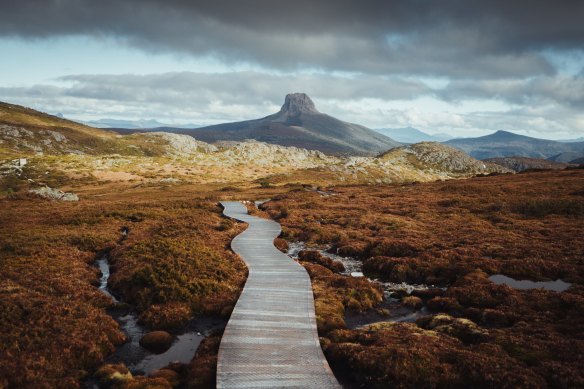
An Overland boardwalk with Barn Bluff in the distance.Credit: Tourism Tasmania
We had a couple of things, though, that our fresh-legged young friend did not have: among them were a priest, a life coach and a journalist. But more of that in a moment. More prosaically, we had good food to look forward to.
This renowned trek through Tasmania’s north-western high country is sensibly divided into a two-speed society. At the public huts and camping grounds, hikers carry their own food, tents and sleeping gear and organise their own trips. The young woman flitting past us was among a large, young and fit looking contingent from Ocean Grove doing that version of the walk.
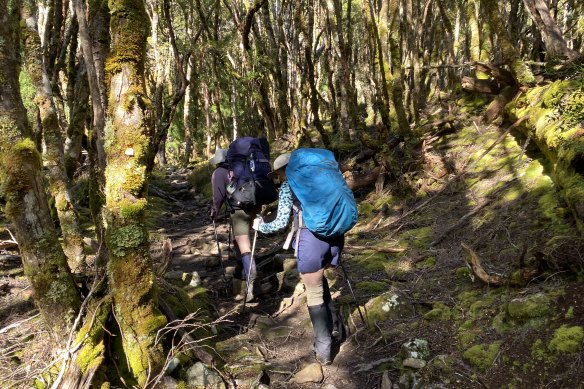
The Overland track winds for six days through extraordinary landscapes in Tasmania’s north-west. Credit: Michael Bachelard
Our group paid more for the other option. Walking in late January and early February, we stayed in a network of separate, private huts run by the Tasmanian Walking Company. These huts are heated, have drying rooms, hot showers and comfortable beds. Our load was literally lighter – our packs contained only clothes and wet weather gear, water, and the day’s packed lunch – about 11 kilograms. Enough to weigh us down, not (quite) enough to break us.
Guides cooked us breakfast and dinner and provided a bunch of local knowledge. One (also an author, poet and general guru) Bert Spinks, dressed like a harlequin, lugged his gargantuan pack on spindly legs and was ready on request with colourful retellings of the local legends, geology and botany.
At the end of each day a crisp glass of good local wine was waiting.
None of this was secret to the Ocean Grove crew. By the time we were flaked out at Du Cane gap, we’d been crossing paths with them for days and bantering about our relative privilege.
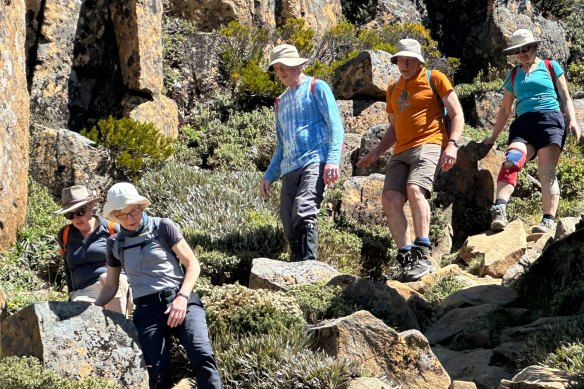
The author and friends descend from the mountain – Tasmania’s highest peak, Mount Ossa.Credit: Neil Millar
“What’s on the menu tonight?” quipped another young thing as she sauntered past, contemplating her evening wrestling with a tent and peeling the tin off the nightly Spam.
“Champagne and lobster,” replied my old mate, Stan, who has not, over many years, lost his penchant for taking the piss.
“That’ll be me one day,” she shot back, “when I’m rich and [with slight bitterness and perfect comedic timing] … old.”
“When you travel / A new silence goes with you, And if you listen, you will hear / What your heart would love to say.”
From the poem “For the Traveller” by John O’Donohue.
For 90 years, walkers have been discovering the Tasmanian bush, and perhaps something about themselves, as they trek the 65 kilometres from Waldheim Chalet, across the moors next to Cradle Mountain, then through rainforest and creek beds, mud puddles and mountains, to Lake St Clair.
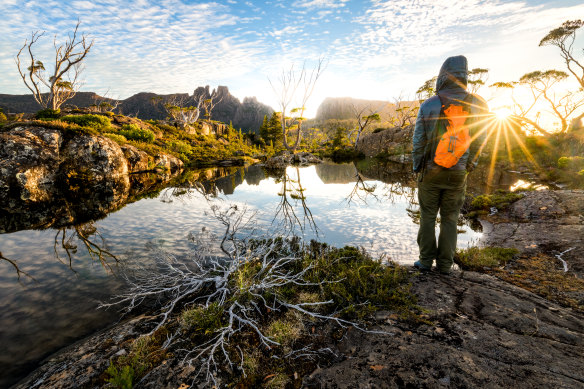
Sunrise over Lake Elysia, Mount Geryon and the Acropolis.Credit: Getty
Apart from some half-hearted 19th century attempts to mine coal and copper and run cattle, and the fur trade built by people like the hardy and hard-drinking pioneer, Bert Nichols, walking has been the only ongoing industry here since white settlement. It was Nichols who first blazed the trail by dabbing lead paint on marks cut into trees, and he opened up the region to cater to the early 20th century craze for tourism on foot.
As a result of these efforts, the land on either side of this well trodden path is virtually untouched. The system of huts and boardwalks, tracks and resting points work their way through a landscape whose every tree, shrub and creature is native born. The water is clear and can be drunk from the streams. Aside from birds, wind, water, and the sound of your own footfall, you can walk in profound silence, if you stop talking long enough.
If nature of this magnificence is a secular temple, this walk is a pilgrimage, and it’s with that spirit that we approached it. My sister Sarah, the priest, runs with her partner, Neil, a contemplative church in Canberra, and for four years the Tasmanian Walking Company has invited them to host an annual walk called Sacred Geography.
Its aim is to approach the landscape meditatively, with openness to the possibility that it can hear us and bring about changes in us.
An atheist (and journalist), I was invited to join her to write about it. For backup, I put out a call to some of my oldest friends. Four responded; two sisters I’ve known for decades, Sue and Cathy, and two other old friends, Stan – a speaker and author who established a life-coaching company – and Gabrielle. These are people whom I can neglect for a year or more at a time, then fall instantly back into the intimacy of our younger, cheekier selves.

The author, Sarah and Neil on Mount Ossa.Credit: Sue Moorhen
The other members of the group – Jenny, a retired academic still coming to terms with the death of her husband, Kerry, a retired senior public servant contemplating her next steps in life, and Karen, a woman facing a recent cancer diagnosis, were, until we began walking together, strangers.
At the beginning of each day as porridge was cooked for us in a giant iron pot on the stove and coffee steeped fragrantly in the plunger, Sarah led us in morning meditation. We wrestled with the root tangles of our own minds in the pursuit of quiet. Then, helped by snippets from the long literature of walking, we prepared for the path ahead.
At day’s end, over dinner at the huge, wooden table, we and our guides would nurse our tired muscles, talk and goof off.
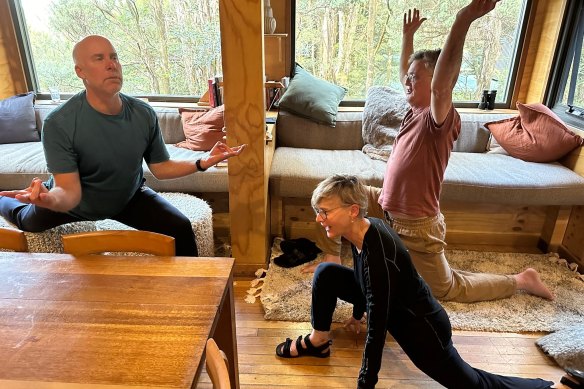
‘Stretching’ in one of the Tasmanian Walking Company’s huts.Credit: Neil Millar
In between, we walked. Our boots were wet for days; we slipped on roots and trudged up rocky creek beds. We learned how to step in mud puddles, not around them (the cultural conditioning on this question is strong).
We walked down into valleys, knees straining, across creeks, then up the other side, thighs now bearing the brunt.
We walked in weather ranging from howling, icy wind and rain to streaming sunlight. We scrambled up boulders to the top of Mount Ossa, Tasmania’s tallest peak, and took in the geological miracle of the region’s monumental vertical rock formations and U-shaped glacial valleys.
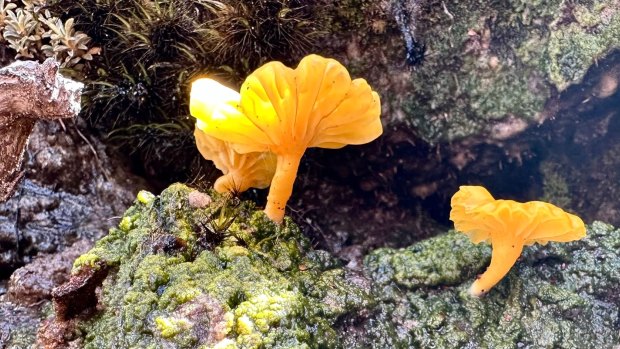
The track hosts a extraordinary array of fungus.Credit: Neil Millar
We saw fungus growing on a tree, which grew over the fungus, which then grew over the tree again. We saw roots snaking over rock shelves hunting for soil, young trees growing in the forks of older trees, moss, lichens, bugs and birds, new things consuming old things, a rash of growth wherever sunlight penetrated – the furious tenacity of life.
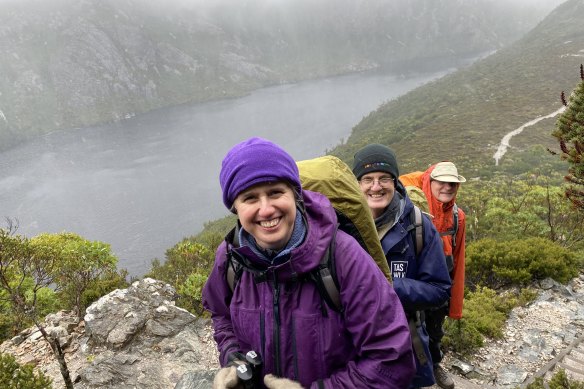
Sue, Stan and Neil in challenging weather at Marion’s lookout, on the first day of six.Credit: Michael Bachelard
Sometimes we were silent. Often we talked, listening to each other, or howling with laughter like old friends.
“The illusion of speed is the belief that it saves time. But haste and speed accelerate time, which passes more quickly ... Days of slow walking make you live longer because you have allowed every hour, every minute, every second to breathe”.
Frederic Gros on “Slowness” from his book, “A Philosophy of Walking”.
As well-marked and well trod as it is, the Overland Track remains a challenge. We lost one in our number on the first day when it became clear on the windy moors that she had overestimated her ability. One of the guides escorted her back out and, as the night closed in, raced back unaccompanied except for a couple of leeches.
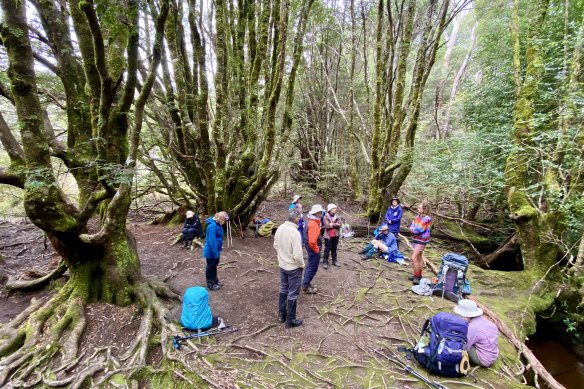
Guide Bert Spinks holds forth at the track’s lowest point, Frog Flats.Credit: Michael Bachelard
We had our backmarkers who were slower, but inspiringly dogged. Having lost a toenail on this hike, Kerry backed up with another multi-day hike after returning to base.
As pilgrims have down the ages, we were connecting to the sublime through the prosaic medium of our feet – imperfect, aching and soggy as they were.
The literature of walking makes it clear how much people through the ages have craved time like this, away from their daily lives, the scramble to make a living, to simply think, and to be.
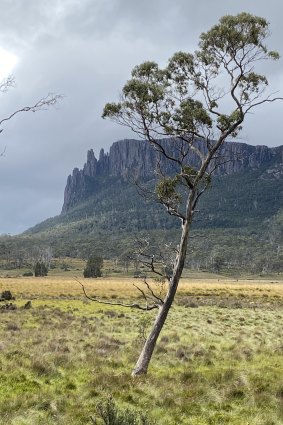
Mount Oakleigh, from the New Pelion Hut.Credit: Michael Bachelard
Around the dinner table on the third night, our discussion turned on these questions: What’s calling you? What urgency deserves to claim you? What are you seeking? The group opened up about the forks in their lives – the gaps left by children leaving home, the careers in need of changing, the grief for a husband, the fear about things ending and the possibility of new beginnings.
Many of us spoke of the lack of silence in our lives to let these things work in us at their own, pedestrian pace, and how grateful we were to be given the space in these six days to allow that to happen.
I was not the only one, I think, who also gave thanks that some things last forever: not just the unspoiled Tasmanian bush, but also family and old friends, the people who love us unconditionally.
Without the chance to do it this way, in huts, not tents, with good food, with friends of all ages, and with packs that did not break us, none of us, I think, would have had the opportunity.
As the Ocean Grove crew strode the path down from Du Cane Gap, these were the things I wanted to say, as a riposte to our cheeky young friend.
And perhaps I would have, if I could have caught up with her.
THE DETAILS
FLY
Fly into Launceston (all major carriers fly there), then meet the group at the Tasmanian Walking Company’s headquarters at The Red Feather Inn, 42 Main Street, Hadspen. TWC offers transfers between Launceston and Hadspen (about 15 minutes).
WALK
On the Overland track, TWC offers a range of walks, including the Signature Walk (with optional mountain ascent side trips) and Adventure Walk (hikers are expected to take all optional mountain climbs). Prices range from $2995 to $5195. Sarah Bachelard’s next Sacred Geography walk will be held from January 23-29, 2025. See taswalkingco.com.au
The writer travelled courtesy of the Tasmanian Walking Company.
Sign up for the Traveller Deals newsletter
Get exclusive travel deals delivered straight to your inbox. Sign up now.